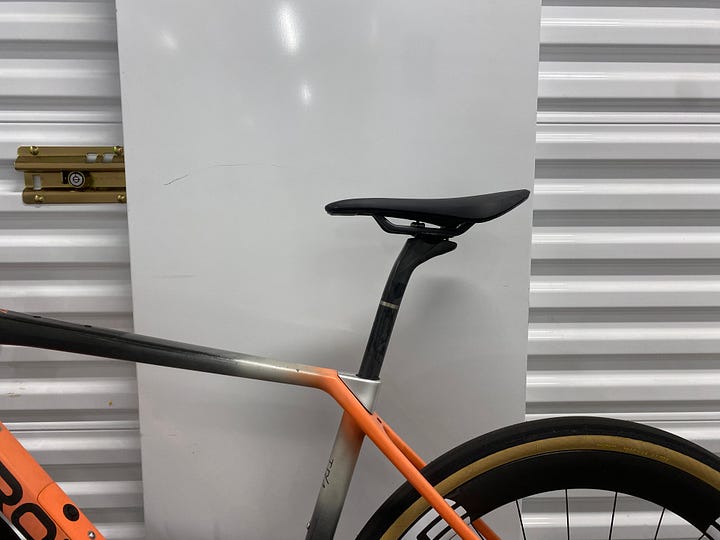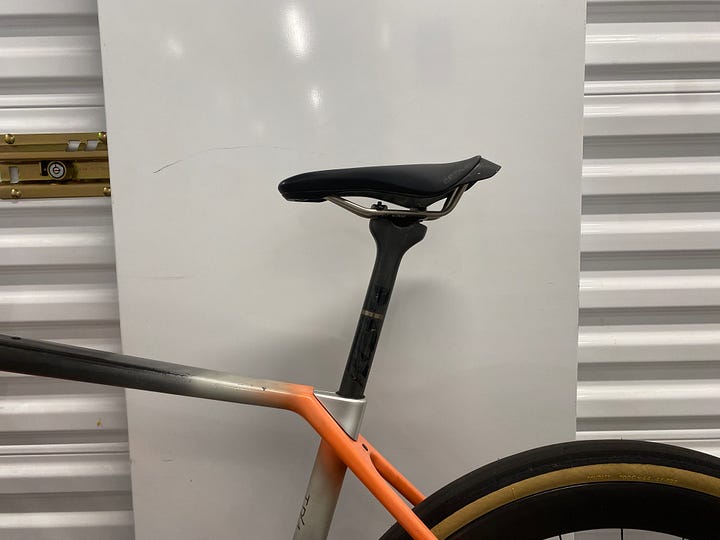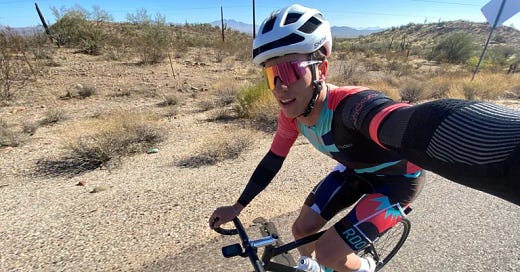We need to talk about seat posts and why I use two
Happy Christmas and merry New Years, consider this a gift you didn’t want or need. Also, a heartfelt apology to Radiohead.
If you thought I was going to wax lyrical about something grand that happened this year, you are mistaken! (I am going to do that next week. But this week I will not!) Today, on this Monday before the day before the New Year I am talking about saddle position this week.
Deal with it.
The lore around the power of the bike fit grows every year. The practice, which has been increasingly seen as essential for serious cyclists, has been buoyed by an improved understanding of the science of body mechanics. It has also, crucially, been aided by measurement technology that gives the fitter more concrete data to work with.
From these advancements, bike fitting seems to only be going up from here as a staple of Correct and Efficient cyclists. But what should you do after a bike fit? This year I made it a pet project to find out.
I have a lot of respect for bike-fitting professionals. When anyone comes into cycling, it is truly necessary to have a professional bike fit to correct all the issues that could befall a new cyclist before they become issues. However, once you know that nothing you’re doing will break you, I suggest you play around and try a thing or two. Then, perhaps, never stop playing. Intuitive feeling around fits, after all, is a feeling you must earn and not one you can be told by a fitter who is not you.
The philosophy of tinkering


Over 2024, I have tried to do this extensively. After a year of riding a bike with a set fit based upon a very solid and scientific bike fit, I decided I wanted to make a change. I wanted to test a new saddle. Well, as luck would have it, the new saddle necessitated a new seat post. The new seat post then was followed by a slight, and I do mean slight, change of stem length. And then, for no real reason at all, I put the old seat post back on with a new, different seat.
That move originally did not feel great. My original fit, which felt solid for a whole year, now felt cumbersome, tiring even. I had grown to love the shift forward I had undergone, and now the setback on the old setup felt impossibly quad-heavy, even if I was able to be a bit lower on the bike and thus more aerodynamic. I also immediately felt more comfortable on uneven terrain.
Despite the discomfort, I kept the other seat post and saddle on for a few rides. It was still the fit I had professionally done and there were lessons to be learned. Ultimately, I got used to the position enough to find the sweet spots to put out power and parse through the other downstream effects of the change. In this case, the immediate downstream effect of saddle position was crank length.
By bringing my saddle forward, I had felt the joy of a pedaling motion where my knee could track further on top of the pedal spindle. While this might not work for everyone, and thus was not a priority of the bike fit that I had, it turns out that is a massive priority for me and a lot of the riding I do. Bringing my seat back also pushed my knee back and I found that I was no longer engaging the same muscles I had with a more progressive saddle and saddle position, especially if I kept my 175mm cranks.
Nevertheless, as I kept the setback seatpost I realized there were scenarios where having the seat further behind the bottom bracket was advantageous. Over rough terrain, I could manage vibrations much better. On sharp or uneven turns, the neutral weight was much better at traction control. Climbing also didn’t seem to suffer since the setback was less impactful when riding in a more upright position. Through switching my seat position it became clear my seat position was much more flexible than what a convention says.
I have since swapped those behemoth 175mm cranks that my misguided 2023 self was convinced was the proverbial “move”, to a pair of 167.5 mm cranks. That change has been a palpable success as the impact of bringing my knee further forward over the spindle has been effective at doubling down on the change that was brought on by the progressive saddle position. At all power levels, I have found that I am recruiting more muscles into my pedal stroke rendering more fluid, “rounded” pedal motion. What’s more, my inflexible hips have enjoyed a more open hip angle in more aerodynamic positions.
The most interesting development, however, is I have continued to alternate between seats and seat posts. I still have my preferences – the progressive setup is best for long tempo days, the traditional post gets the nod on the chunky climbing days – but regardless I plan on continuing to operate with both options in my repertoire. This kind of tinkering would seem sacrilegious for most bike fitters. In their pursuit of optimal fits, they have what they deem best, what they prioritize. But, like most things as dynamic as sitting on a gravel bike, those guardrails are a philosophy rather than a rule, and philosophies of any kind should be tested and tinkered with.
The way I look at it is that between the two posts and saddles, I can fit my bike to the effort in a similar way that I can swap chainrings or tires. The bike and rider are all part of a system and in gravel racing, that system can, and should, be as dynamic as the activity itself. It all matters much more than it does when the road is smooth and riding positions are fairly binary.
For your eyes and ears
Last month, I rode a fixed-gear bike 100 miles. It was a special ride for a few reasons, and fortunately, Cycling Weekly let me write a boatload of words about it. Check that out here.
The Cycling Podcast sat down with Rolf Aldag of Red Bull-Bora-Hansgrohe to discuss the team's transformation over the past year and the plans for their continued evolution in the year to come. It is fascinating to get a glimpse behind the curtains of the era of revolution in the WorldTour we are sure to look back on as a time when everything changed.
I recorded a podcast with Jeff Chapman the other day. Chances are you don’t know Jeff, but it is rare that I get to record conversations like that, even if I have them all the time. It is well worth the listen!
A side of something else
I have a confession to make. I have said I don’t like Radiohead a few times—actually, I have said I don’t like Radiohead so many times. It’s embarrassing because I actually really like Radiohead; I just didn’t know that until yesterday.
Like many, I knew Radiohead through their song Creep and Creep only. And I don’t have a lot of love for Creep, so I haven't had a lot of love for Radiohead.
What is most embarrassing about the whole embarrassing thing, though, is I haven’t actually only heard Creep. I have heard many Radiohead songs through the osmosis of general life as an early-stage Gen Z dude who likes many Radiohead-adjacent bands. (Think Pixies, The Strokes, Peal Jam, but definitely not Oaisis). Radiohead have been all around without me even knowing, or trying to know, more about them than a song that they themselves also dislike. That’s on me, and I hope you’ll forgive me, because as I queued up the Radiohead album “OK Computer”. Immediately I felt elated, and I felt shame. Elated that I had a new lavish collection of s-tier rock songs and one strange AI interlude to guide me through the Superstition mountains at the end of a 24-hour riding week. Shame that it took me so long and that I lied to so many people.
Do me a favor, and queue up Radiohead tomorrow on your next ride. Even if you think you don’t like it, even if you hate Creep, you too could be living a lie.




